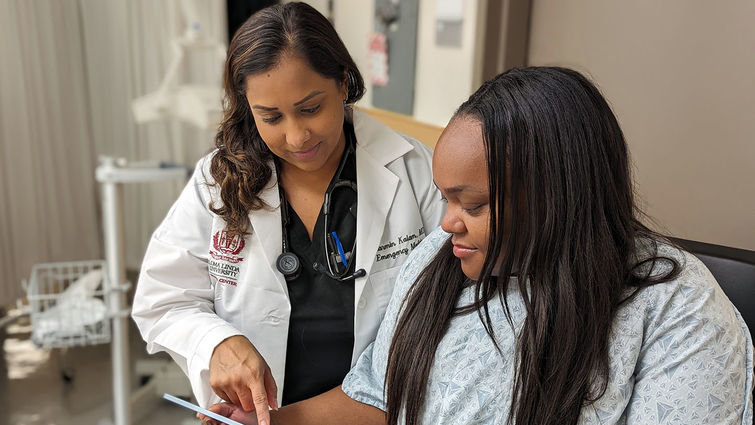
Emergency medicine physician Sharmin Kalam, MD, introduces the screening tool to a patient.
Loma Linda University School of Behavioral Health, in partnership with Loma Linda University Medical Center (LLUMC), received a $1.5 million grant to house a comprehensive behavioral healthcare and HIV prevention and care program inside the LLUMC Emergency Department.
In recent years, the Inland Empire has seen a 23% rise in new HIV diagnoses, according to the California Department of Public Health. Alarming rates of HIV in the region emphasize the need for HIV testing.
The five-year grant from the U.S. Department of Health and Human Services (HHS) will provide HIV and Hepatitis C Virus testing in the LLUMC Emergency Department (ED) and improve linkage to prevention services and care among racial and ethnic minority populations at high risk for Substance Use Disorders (SUDs) and HIV infection.
The Substance Abuse and Mental Health Services Administration (SAMHSA) awarded nearly $35 million in grant funding last month to bring essential behavioral health services and HIV prevention and care to historically underserved populations across the U.S. — a key focus of the Biden-Harris Administration.
San Bernardino and Riverside counties are among the hardest hit by HIV in California, according to the CDC. Its residents are also among the least tested in the nation.
Oleksandr Dubov, PhD, associate professor at LLU School of Behavioral Health, said the urgency of this program is driven by the decrease in HIV testing nationwide due to the COVID-19 pandemic.
An estimated 2,500 people in the Inland Empire are living with HIV without knowing their status, which equals 18% of the estimated 14,000 individuals living with HIV in the area, according to the California Department of Public Health.
The significance of HIV testing is emphasized by the Ending the HIV Epidemic (EHE) initiative, a comprehensive effort by the HHS to reduce HIV incidence by 90% within a decade. Riverside and San Bernardino Counties, both part of the 48 high-burden U.S. counties identified by EHE, face a severe HIV epidemic coupled with low testing rates.
“Ensuring Inland Empire residents are aware of their HIV status is crucial to curbing the epidemic,” Dubov said. “A startling 80% of new HIV infections can be traced back to undiagnosed individuals or people who are diagnosed but not engaged in care.”
Dubov said emergency departments play a pivotal role in this effort as they serve as the primary source of healthcare for some of the highest-risk individuals.
“Given that members of the Latinx and Black communities are more likely to seek healthcare in emergency departments, the ED becomes a critical hub for HIV testing, care linkage, and prevention,” Dubov said.
Loma Linda University Medical Center’s Emergency Department is the only Level 1 Trauma Center in the Inland Empire, treating a population equal to 25 percent of California — with 164,006 ED visits in 2022.
Sharmin Kalam, MD, emergency medicine physician at Loma Linda University Medical Center, said the ED is now working to implement consistent HIV screening protocols because of the high prevalence of HIV in the Inland Empire.
“Previous gaps in testing and care have led to missed opportunities for diagnosing HIV and connecting patients to vital treatment and prevention services,” Kalam said. “Funding from the SAMHSA grant will build upon the work initiated in our ED, sponsored by a 2021 EHE pilot grant led by principal research investigator Oleksandr Dubov, PhD.”
Kalam said in a busy ED, a trained counselor can offer necessary pre- and post-test HIV counseling, educate patients on prevention methods, support highly effective Pre-exposure Prophylaxis (PrEP) initiation, and facilitate linkage to care for patients with SUD or HIV.
“Research suggests that using trained counselors is a particularly well-suited approach to reach patient populations that are highly stigmatized and potentially mistrustful of healthcare professionals," Kalam said.
E-screening at the ED will be used to identify patients who may be at risk of contracting HIV and would benefit from additional services and testing.
“Due to stigma concerns, many of these patients decline HIV testing, but e-screening engages them discreetly and addresses barriers to HIV testing privately,” Kalam said. “This tool also assesses both HIV and substance use disorder risks, allowing for the coordinated provision of services in the ED.”
Trained counselors from the same demographic will provide intervention, ensuring culturally sensitive counseling, testing, and linkage to healthcare services.
“Guidance from experts from our ED team, School of Behavioral Health, and Behavioral Medicine Center will be instrumental in hiring and training our clinical counselors tasked with this vital new role,” Kalam said.


